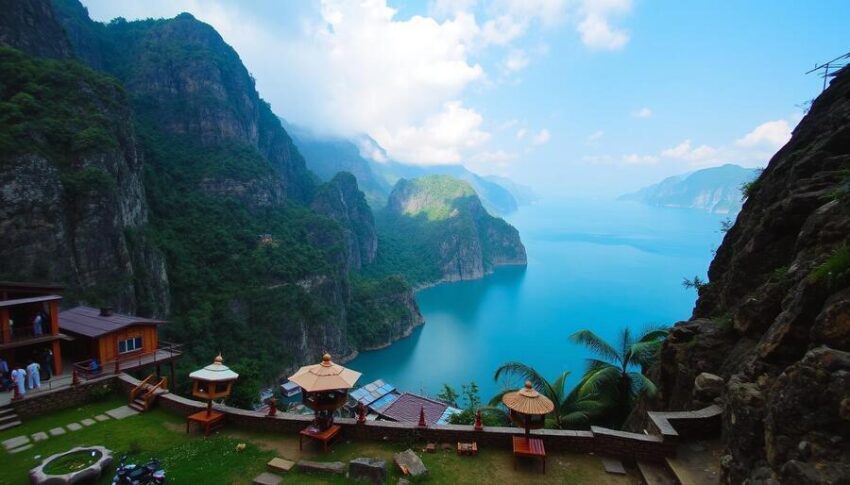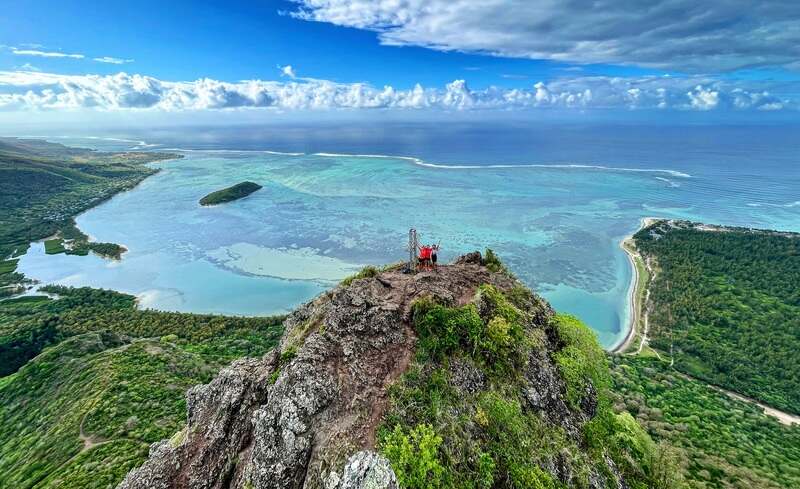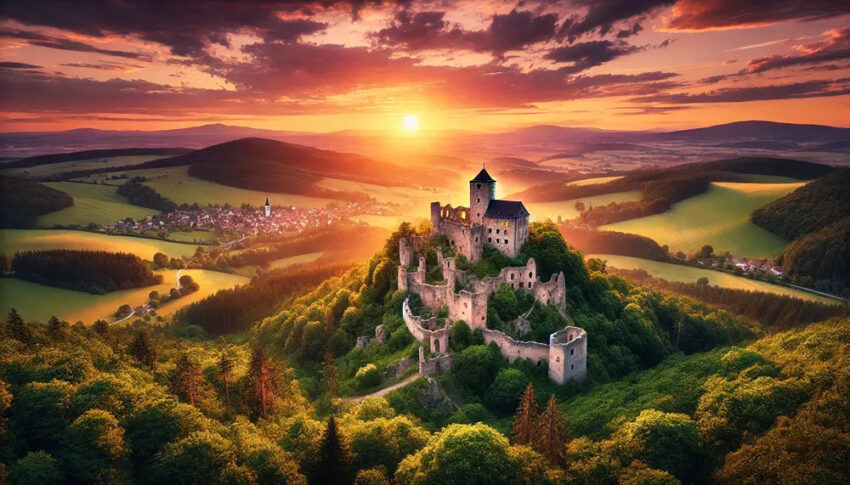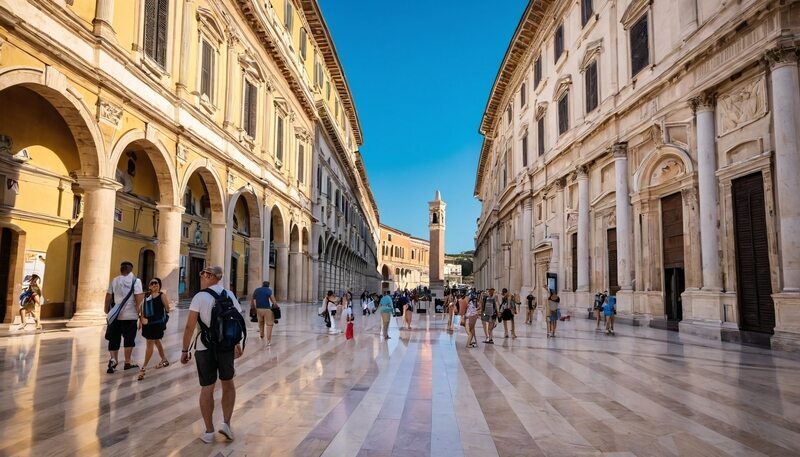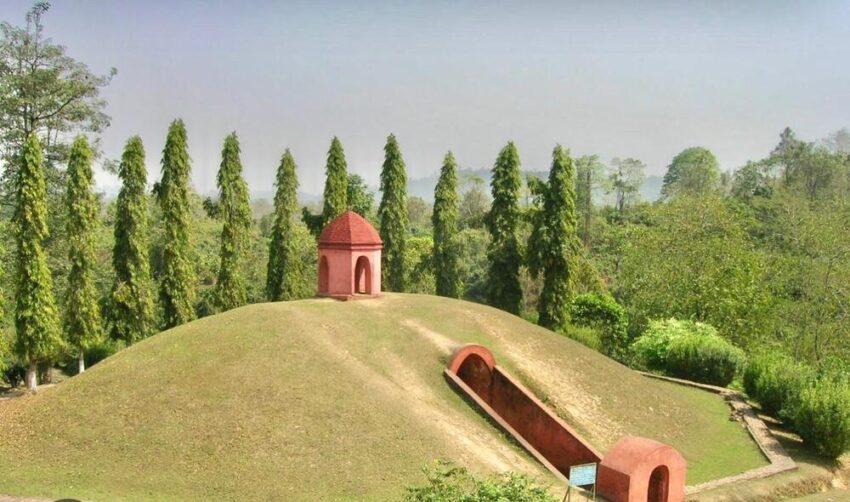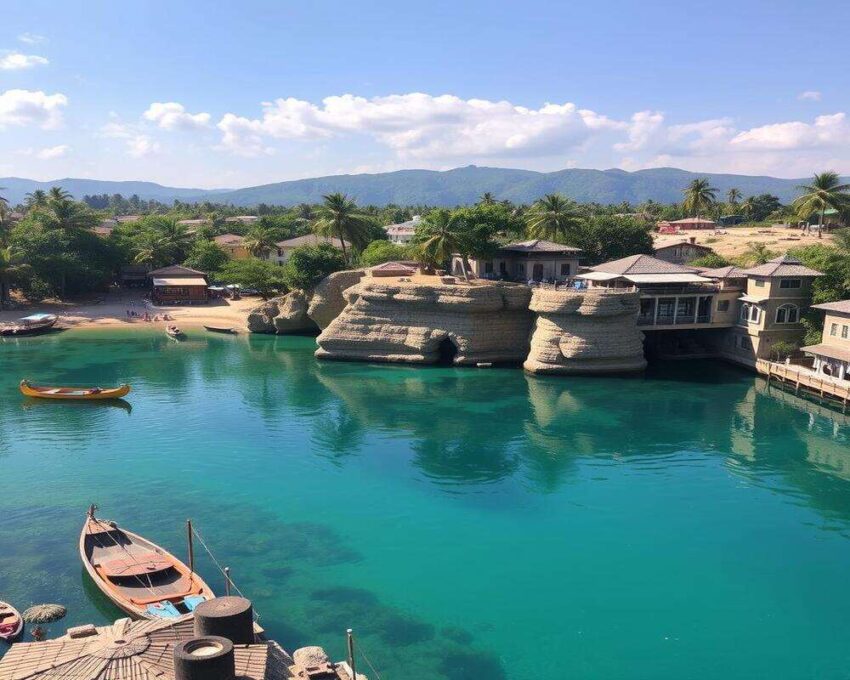Reading Time: 10 minutes
Moidams are ancient megalithic tombs found in Assam, India, particularly in the Dima Hasao district. Dating back to the Neolithic period, approximately between 2000 BCE and 1500 BCE, these large stone structures were built as tombs for the dead. Moidams are an integral part of India’s rich cultural and historical heritage, offering valuable insights into the lives and practices of ancient civilizations.
Nestled in the foothills of the Patkai Ranges in eastern Assam, the site features the royal necropolis of the Tai-Ahom. For 600 years, the Tai-Ahom people constructed Moidams (burial mounds) that harmonized with the natural landscape of hills, forests, and water, creating a sacred geography. Banyan trees, along with trees used for coffins and bark manuscripts, were planted, and water bodies were created to enhance the site’s significance.
Assam has witnessed a staggering surge in tourism, with domestic tourist numbers skyrocketing by 573% and foreign tourist arrivals soaring by 783% in 2023, according to Assam Tourism Minister Jayanta Malla Baruah. The Minister highlighted that this remarkable growth follows significant improvements in law and order over the past two years under the current state government. The absence of protests and bandhs, coupled with enhanced infrastructure and the establishment of new branded hotels and luxury resorts in Guwahati, Kaziranga, Manas, and other areas, has contributed to this tourism boom.
Exploring the Charaideo Necropolis: A Sacred Site of Ninety Moidams and Enduring Tai-Ahom Rituals
The property contains ninety moidams—hollow vaults built of brick, stone, or earth—of varying sizes. These moidams hold the remains of kings and other royals, along with grave goods such as food, horses, and elephants, and occasionally even queens and servants. The Tai-Ahom rituals of “Me-Dam-Me-Phi” and “Tarpan” are still practiced at the Charaideo necropolis. While moidams are also found in other parts of the Brahmaputra Valley, this site is particularly noteworthy for its historical and cultural significance.
Exploring Moidams: Top Seasons for Visiting the Megalithic Tombs with Ideal Weather and Beautiful Landscapes
Winter (December to February): This is the best time to visit Moidams, with comfortable temperatures (10-20°C/50-68°F) and minimal rainfall. The weather is ideal for exploring the megalithic tombs and surrounding areas.
Spring (March to April): Spring is another great time to visit Moidams, with mild temperatures (15-25°C/59-77°F) and blooming flowers. The scenery is picturesque, making it perfect for photography and nature walks.
Autumn (September to November): Autumn is a good time to visit Moidams, with comfortable temperatures (15-25°C/59-77°F) and fewer tourists. The scenery is beautiful, with the surrounding hills turning golden yellow.
Assam’s Moidams Witness a Tourism Boom
Since being nominated for UNESCO World Heritage status, the Moidams in Assam have seen a remarkable surge in tourist arrivals. These ancient marvels are not only showcasing Assam’s rich cultural tapestry but also shedding light on the state’s fascinating history and traditions. The local communities are actively involved in preserving and promoting the Moidams, cultivating a deep sense of ownership and pride. As a result, the Moidams are emerging as a cultural hub, attracting visitors from far and wide, and contributing to the state’s economic growth.
Airports in Assam, India:
Lokpriya Gopinath Bordoloi International Airport, located in Guwahati, Assam, is the main and busiest airport in the northeastern region of India. As a major international gateway, it connects the region to various national and international destinations, handling a passenger traffic of 5,957,609.
Rupsi Airport, located in Assam, India, serves as a gateway to the northeastern region, primarily handling domestic flights. As a key access point for travelers visiting the scenic areas of lower Assam, Rupsi Airport accommodated 33,257 passengers, highlighting its importance as a regional hub.
Dibrugarh Airport, also known as Mohanbari Airport, serves the city of Dibrugarh in Assam and is a crucial air travel hub for the upper Assam region. It connects passengers to major cities like Delhi, Kolkata, and Guwahati, handling 745,876 travelers.
Jorhat Airport, commonly referred to as Rowriah Airport, is a domestic airport located in Assam. It plays a crucial role in connecting the city of Jorhat and nearby regions to key destinations, with a passenger traffic of 168,468.
Lilabari Airport, situated in Lakhimpur district, Assam, near the Arunachal Pradesh border, primarily handles domestic flights. It serves as a vital connection for travelers to the northeastern states, with a passenger traffic of 36,172.
Silchar Airport, also known as Kumbhirgram Airport, is located in Assam and serves the Barak Valley region. It is a key air transport hub, connecting Silchar with major cities like Kolkata and Guwahati.
Tezpur Airport, also known as Salonibari Airport, serves the city of Tezpur in Assam. It is a domestic airport that provides essential connectivity to the northeastern region, with flights to cities like Kolkata and Guwahati.
Recommended Hotels Near the Moidams in Assam:
Hotel Jora Palace: Situated at 3, Raja Maidam Road, near Malpani Nursing Home, in Jorhat, offering convenient access to the historic Moidams.
Okegiga Homes: Located at Chitadar Chuk Garamur, in Majuli, providing a serene retreat amidst the cultural heritage of Assam.
MD’s Continental: Found at Marwari Patty, in Jorhat, offering comfortable accommodations with easy access to nearby attractions, including the Moidams.
Mancotta Heritage Chang Bungalow: Positioned on Mancotta Road within the Mancotta Tea Estate, in Dibrugarh, offering a heritage stay experience near the region’s historical sites.
Pushkara Sarovar Portico: Located at Natun Gaon, NH 37, P.O. Mohanaghat, behind the Mahindra Dealership, in Dibrugarh, providing modern amenities in proximity to the region’s cultural landmarks.
Kaziranga Golf Resort: Located 15 kilometers from Jorhat City, this resort offers a serene environment with a beautiful property and a games room featuring carrom, table tennis, chess, and a pool table. It’s an excellent base for exploring nearby attractions, including the historic Moidams.
Hotel Gulmohar Grand: A small annexe of the main Gulmohar Grand hotel, situated about 200 meters away, this new construction provides comfortable accommodations with room service from the main hotel, offering convenient access to local sites, including the Moidams.
Thengal Manor: This elegant property combines old-world charm with excellent service and traditional Assamese cuisine, making it a perfect retreat for those interested in exploring the rich cultural heritage of the Moidams.
Bononi: A bed and breakfast known for its warm hospitality, Bononi offers delicious meals prepared with fresh vegetables from its expansive garden, providing a relaxing stay with easy access to nearby Moidam sites.
Hotel Jora Palace: Nestled within the bustling bylanes of AT Road near HDFC bank, this hotel features quick check-in procedures and comfortable rooms, ideal for visitors planning to explore the historic Moidams and other local attractions.
Gibbon Resort: Surrounded by nature, this resort offers a peaceful escape from everyday life, with dewy mornings filled with the sounds of birds, making it a perfect spot for visitors interested in the Moidams and Assam’s natural beauty.
Explore Assam: From Majestic National Parks to Cultural Hubs
Kaziranga National Park: A UNESCO World Heritage Site, Kaziranga is home to two-thirds of the world’s population of the one-horned rhinoceros.
Manas National Park: Recognized as a UNESCO Natural World Heritage site, Manas is also a Project Tiger Reserve, Elephant Reserve, and Biosphere Reserve.
Majuli Island: The world’s largest river island, situated in the Brahmaputra River, known for its unique culture and natural beauty.
Dibrugarh: The largest city in Assam, located 439 km from Guwahati, and a major center for tea production and commerce.
Jorhat: Known as the tea capital of India, Jorhat is a culturally and commercially significant city in Assam.
Hajo: An ancient pilgrimage center that attracts followers of Hinduism, Islam, and Buddhism, showcasing religious harmony.
Mayong: A cluster of villages 40 km from Guwahati, famously known as the ‘land of black magic’ due to its historical association with mysticism.
Dibru Saikhowa National Park: A protected area in the Endemic Bird Area of the Assamese Plains, known for its rich biodiversity.
Pobitora Wildlife Sanctuary: Renowned for having the world’s densest population of one-horned rhinoceroses.
Nameri National Park: Known for its elephant population and diverse wildlife, including tigers, leopards, gaurs, wild pigs, and sambars.
India the World’s Most Populous Democracy, A Land of Diverse Cultures and Unforgettable Tourism Experiences
India, officially known as the Republic of India, is a country in South Asia. It ranks as the seventh-largest country by area and became the world’s most populous nation as of June 2023. Since gaining independence in 1947, it has also been the world’s largest democracy. India is a land of diverse cultures, rich history, and breathtaking natural beauty, offering a truly unique and unforgettable tourism experience. From the majestic, snow-capped peaks of the Himalayas to the sun-drenched beaches of the south, India’s vast landscape is home to countless attractions that cater to every interest and preference.
India Sees Remarkable Surge in Tourist Arrivals
India witnessed a remarkable increase in tourist arrivals, with numbers growing from 4.1 million in 2022 to 8.5 million in 2023, and reaching 13.34 million in 2024, marking a significant year-on-year surge. This impressive growth highlights India’s rising appeal as a global travel destination, driven by its rich cultural heritage, diverse landscapes, and expanding infrastructure. The upward trend reflects the country’s successful efforts to enhance its tourism offerings, making it an increasingly popular choice for international travelers seeking unique and memorable experiences.
Moidams in Assam: A Hidden Gem Transforming India’s Tourism with Global Recognition, Unique Experiences, and Enhanced Accessibility
The Moidams stand out as an off-the-beaten-path destination, offering an alternative to more conventional tourist sites. This appeals to travelers seeking unique and less-explored locations.
The Moidams, ancient megalithic tombs in Assam, are transforming India’s tourism landscape, drawing increasing attention and visitors. This surge in popularity is largely due to their nomination for UNESCO World Heritage status, which has sparked global interest and attracted travelers from across the world. The cultural significance of these ancient structures offers a unique insight into India’s rich heritage, showcasing the country’s history and traditions in a way that appeals to those seeking more offbeat destinations. The Moidams provide an alternative to conventional tourist spots, catering to the growing demand for unique and immersive experiences. Local communities play a vital role in preserving and promoting these sites, ensuring that visitors enjoy an authentic and engaging experience. Coupled with improved infrastructure and amenities, access to the Moidams has become more convenient, further boosting their appeal. Additionally, digital promotion through social media and online platforms has effectively showcased the beauty and significance of the Moidams, attracting a new generation of travelers. As a result, the Moidams are emerging as a flagship tourist destination in India, driving economic growth and fostering cultural exchange.
UNESCO World Heritage Nomination: The Moidams’ nomination for UNESCO World Heritage status has put them on the global map, attracting tourists and history enthusiasts from around the world.
Enhanced Accessibility: With improvements in infrastructure and amenities, the Moidams have become more accessible to tourists, facilitating easier travel and exploration of the site.
Digital and Social Media Promotion: The effective use of social media and digital platforms has highlighted the Moidams’ significance and beauty, attracting a younger, tech-savvy audience eager to explore these ancient structures.
Moidams are poised to become a flagship attraction, beckoning travelers to explore the state’s hidden treasures.
India’s Tourism Sector Boosts Economy with Significant GDP Contribution and Earnings from a Surge in Foreign Visitors in 2022
In 2022, India’s travel and tourism industry made a significant impact on the country’s economy, contributing approximately 190 billion U.S. dollars to the national GDP. During the same year, India welcomed over six million foreign tourists, highlighting the country’s growing appeal as a global destination. This influx of visitors generated substantial foreign exchange earnings, amounting to over 16.93 billion U.S. dollars. The robust performance of the tourism sector underscores its vital role in driving economic growth, creating employment opportunities, and showcasing India’s rich cultural and natural heritage to the world.
India’s Major Airports-Key Hubs Connecting Millions of Passengers to Global Destinations:
Indira Gandhi International Airport, located in New Delhi, is the busiest airport in India and a major hub for international and domestic flights. It serves as a key gateway to India, handling 7.36 crore (73.6 million) passengers annually and offering connections to destinations worldwide.
Kempegowda International Airport in Bengaluru, Karnataka, is among India’s busiest airports, serving as a major hub for both domestic and international flights. Connecting Bengaluru to key global destinations, the airport handled 37.53 million passengers, known for its modern infrastructure and efficient services. It plays a vital role in supporting business and tourism in the region.
Chhatrapati Shivaji Maharaj International Airport in Mumbai is one of India’s busiest and most vital airports, serving as a major hub for both domestic and international flights. With passenger traffic of 13.46 million, it is renowned for its modern facilities and acts as a key gateway, connecting Mumbai to cities across the globe.
Luxurious hotels to stay in India:
Umaid Bhawan Palace, Jodhpur: One of India’s grandest private hotel residences, offering the signature Taj Hospitality with royal butler service, exclusive dining experiences, and luxurious shopping options.
The Oberoi, New Delhi: A hotel embodying the essence of India’s capital, featuring spacious rooms and suites equipped with state-of-the-art technology and offering panoramic views of Delhi Golf Course and Humayun’s Tomb.
Aman-i-Khas, Ranthambore National Park: A luxury safari retreat on the edge of Ranthambore National Park, offering daily Jeep safaris and spa treatments beneath candlelit canopies, inspired by the grandeur of Mughal hunting camps.
The Taj Mahal Palace, Mumbai: A stunning hotel blending Moorish, Oriental, and Florentine architectural styles, featuring an extensive collection of art and artifacts and a Jiva Spa set amidst a serene swimming pool.
Ananda in the Himalayas: A tranquil retreat designed for spa enthusiasts, offering luxurious accommodations and a 24,000-square-foot spa with over 80 treatments, all set against the breathtaking backdrop of the Himalayas.
Taj Falaknuma Palace, Hyderabad: Once the royal residence of the Nizam of Hyderabad, this palace offers opulent guestrooms adorned with Hyderabadi and English frescoes, along with a Jiva Spa for a regal relaxation experience.
Iconic Landmarks of India:
Taj Mahal, Agra: An eternal symbol of love and one of the world’s most iconic monuments, renowned for its stunning marble architecture.
Red Fort, Delhi: A historic emblem of the Mughal dynasty, this imposing red sandstone fort stands as a testament to India’s rich history.
Golden Temple, Amritsar: The most revered Sikh shrine, known for its spiritual significance and breathtaking gold-covered architecture.
Amer Fort, Jaipur: A majestic fort perched on a hilltop, celebrated for its intricate architecture and panoramic views of Jaipur.
Hawa Mahal, Jaipur: A five-story architectural marvel, known for its unique facade and historical significance in the heart of Jaipur.
India‘s tourism presents a rich and diverse tapestry, offering experiences that blend ancient heritage, vibrant culture, and breathtaking natural beauty. From iconic landmarks like the Taj Mahal and Red Fort to the serene Golden Temple and majestic forts of Rajasthan, the country’s attractions cater to every kind of traveler. Amidst these well-known destinations, the Moidams of Assam are emerging as a unique and enriching experience for those seeking off-the-beaten-path adventures. Steeped in history and tradition, these megalithic tombs offer a window into Assam’s ancient cultural heritage.
With growing global interest and the potential for UNESCO World Heritage status, the Moidams are poised to become a key highlight in India’s cultural tourism landscape. The active involvement of local communities in preserving these sites ensures that visitors enjoy an authentic experience, while improved infrastructure and digital promotion continue to enhance their accessibility. As Moidam tourism flourishes, it not only contributes to regional economic growth but also deepens the global appreciation for India’s diverse history and cultural legacy. Together, these destinations showcase the incredible diversity of India’s tourism offerings, making the country a captivating and enduring destination for travelers from around the world.
The post How UNESCO’s Moidams in Assam is Powering India’s Tourism Sector appeared first on Travel And Tour World.

